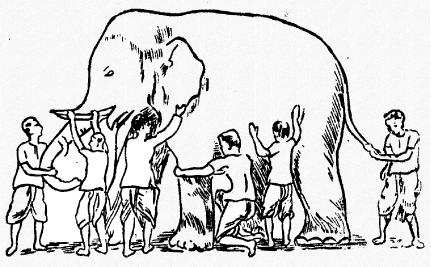Understanding Our Elephant
The information architecture community has much to learn from this expansive, honest, multifaceted approach to strategy. We are a young field, and we often resemble the illustration that accompanies The Blind Men and the Elephant (Figure 18-6). We have yet to develop our schools of thought. And our elephant is a complex, dynamic, and elusive beast. Building towards a collective understanding of information architecture is exasperatingly difficult.

Figure 18-6. The Blind Men and the Elephant (image from http://www.jainworld.com/literature/story25i1.gif)
As we continue to formulate our ideas and methods, we should be wary of those who expound a “one best way.” We should embrace many definitions, many methods, and many facets. We should also be on the lookout for early indicators of trends that suggest new directions and new schools of thought for information architecture. It would be naïve to think our practice has matured in less than a decade.
This is not to say that we haven’t made great progress already. The practice of information architecture has come a long way since the early 1990s. We began with highly centralized, top-down approaches, attempting to leverage careful planning into stable solutions. We did some good work, but learned the hard way that change is a constant and surprises should be expected. More recently, we’ve been exploring bottom-up ...
Get Information Architecture for the World Wide Web, Second Edition now with the O’Reilly learning platform.
O’Reilly members experience books, live events, courses curated by job role, and more from O’Reilly and nearly 200 top publishers.

